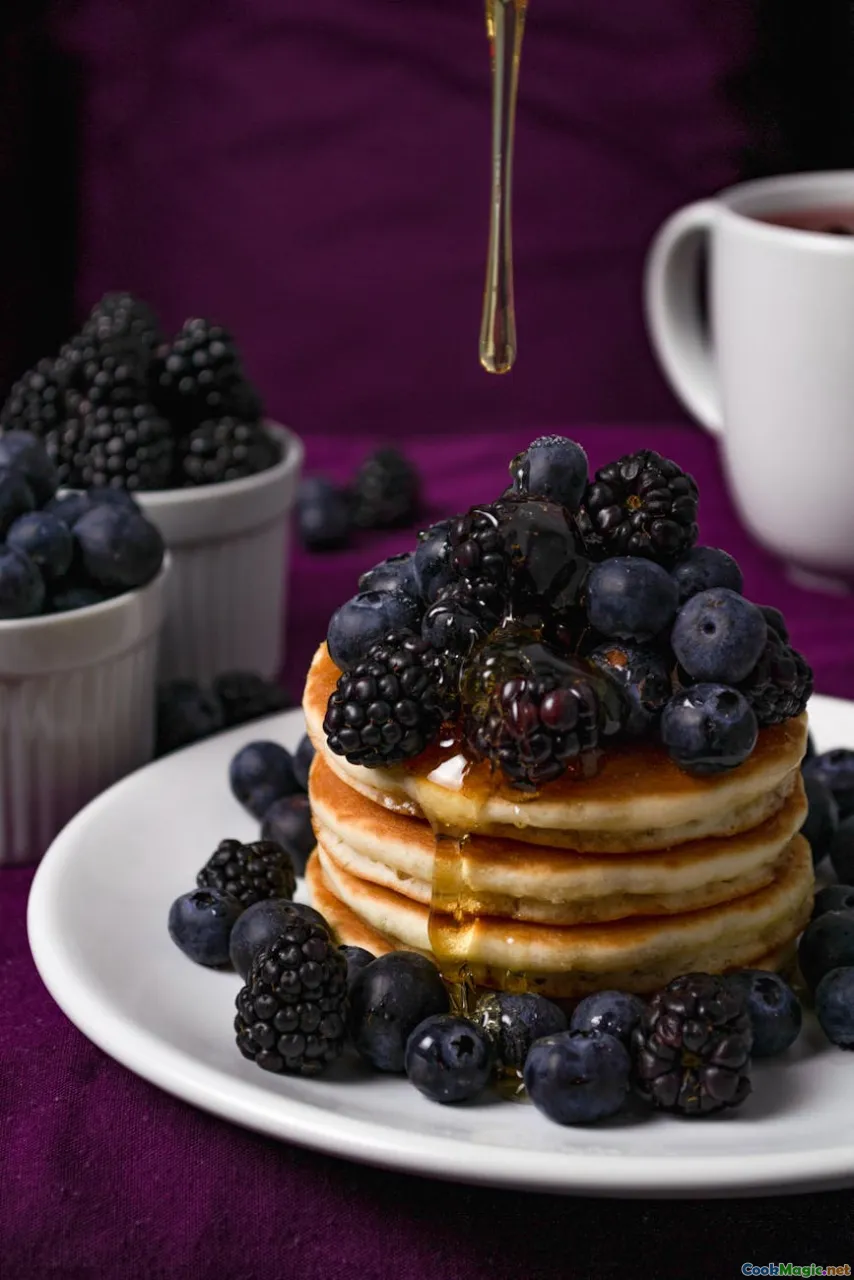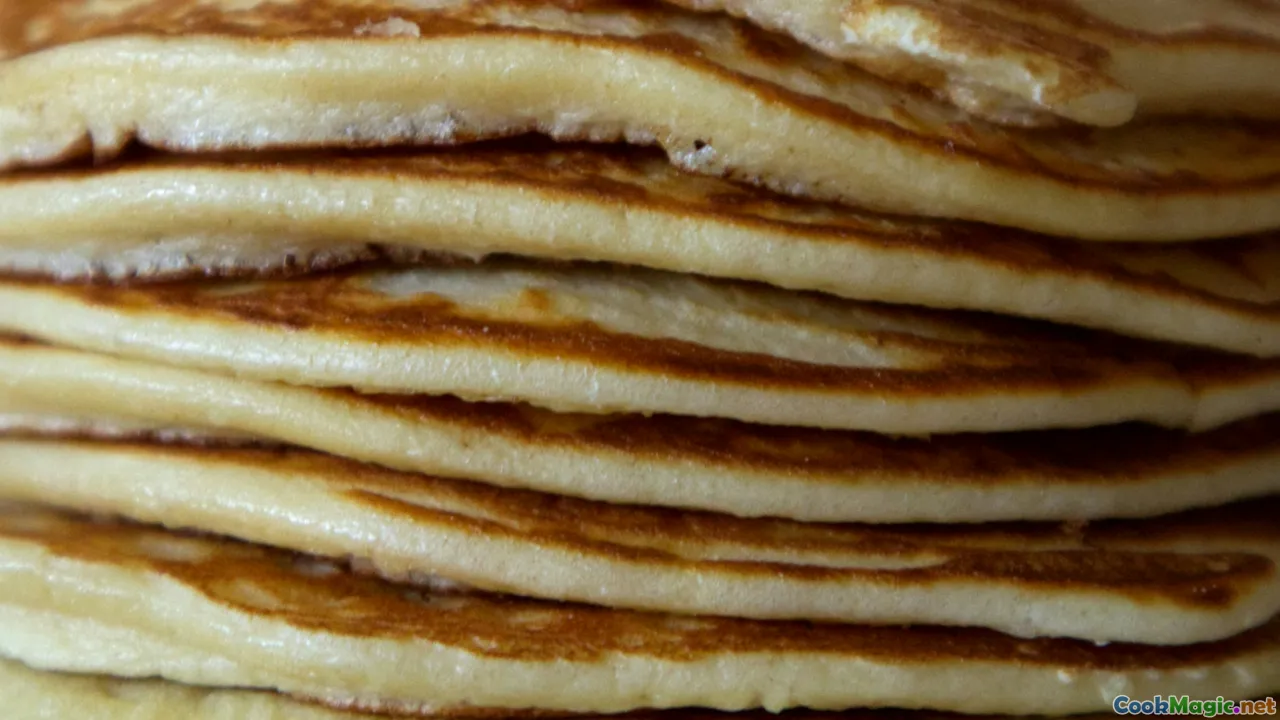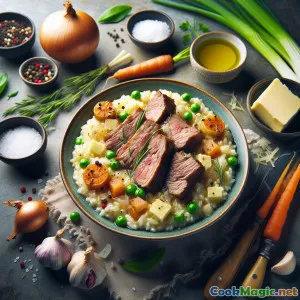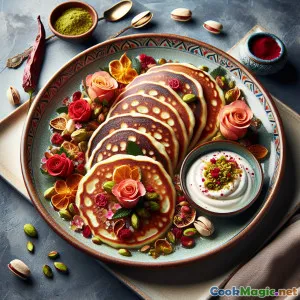
Placuszki z karobu z wyspy Mljet z miodem sosnowym
(Mljet Island Carob Pancakes with Pine Honey)
(0 Recenzje)0
173
październik 03, 2025
Zgłoś problem
Składniki
-
60 grams Proszek karobu (rogič/rogač)
(Sift to remove lumps for a lighter batter)
-
140 grams Mąka uniwersalna
(Can replace 40g with whole wheat for heartier texture)
-
2 tsp Proszek do pieczenia
(Provides lift to balance dense carob)
-
0.25 tsp Soda oczyszczona
(Helps browning and tenderness with yogurt)
-
0.25 tsp drobna sól morska
(Enhances chocolatey notes of carob)
-
1 tsp Skórka pomarańczowa
(Freshly grated; traditional Dalmatian citrus aroma)
-
2 large duże jajka
(Temperatura pokojowa dla lepszej emulsyfikacji)
-
120 grams Jogurt Grecki
(Adds tang and moisture)
-
240 ml Mleko
(Use whole milk or goat milk for richness)
-
2 tbsp Oliwa z oliwek extra virgin
(In the batter for tenderness)
-
1 tsp Ekstrakt waniliowy
(Complements carob’s natural sweetness)
-
1 tbsp Rakija (brandy winne) lub likier Maraschino
(Optional aromatic nod to the coast; leave out for alcohol-free)
-
1 tbsp Neutralny olej lub masło do patelni
(do natłuszczenia patelni)
-
60 ml Miód sosnowy (lub miód kwiatowy)
(Warm slightly for an easy drizzle)
-
30 grams Orzechy włoskie, grubo posiekane
(Lightly toast for deeper flavor)
-
40 grams Suszone figi, posiekane
(Optional island-style topping)
-
0.5 tsp Cynamon
(Warm spice that lifts carob)
(Sift to remove lumps for a lighter batter)
(Can replace 40g with whole wheat for heartier texture)
(Provides lift to balance dense carob)
(Helps browning and tenderness with yogurt)
(Enhances chocolatey notes of carob)
(Freshly grated; traditional Dalmatian citrus aroma)
(Temperatura pokojowa dla lepszej emulsyfikacji)
(Adds tang and moisture)
(Use whole milk or goat milk for richness)
(In the batter for tenderness)
(Complements carob’s natural sweetness)
(Optional aromatic nod to the coast; leave out for alcohol-free)
(do natłuszczenia patelni)
(Warm slightly for an easy drizzle)
(Lightly toast for deeper flavor)
(Optional island-style topping)
(Warm spice that lifts carob)
Wartości odżywcze
- Porcje: 4
- Wielkość porcji: 2 naleśniki (180g)
- Calories: 410 kcal
- Carbohydrates: 54 g
- Protein: 11 g
- Fat: 16 g
- Fiber: 8 g
- Sugar: 19 g
- Sodium: 260 mg
- Cholesterol: 70 mg
- Calcium: 220 mg
- Iron: 3.2 mg
Instrukcje
-
1 - Sift and whisk dry ingredients:
In a large bowl, sift carob powder, flour, baking powder, and baking soda. Whisk in sea salt and cinnamon to evenly distribute leaveners and spices.
-
2 - Combine Wet Ingredients:
In a separate bowl, whisk eggs, yogurt, milk, olive oil, vanilla, and orange zest until smooth. If using rakija or Maraschino, whisk it in now.
-
3 - Make the Batter:
Pour wet mixture into the dry. Stir gently with a spatula until just combined. A few small lumps are fine—avoid overmixing to keep pancakes tender.
-
4 - Rest the Batter:
Let the batter rest 5–10 minutes. This hydrates the carob and flour, allowing gluten to relax and leaveners to activate.
-
5 - Preheat skillet:
Heat a nonstick or well-seasoned cast-iron skillet over medium heat. Lightly grease with neutral oil or a touch of butter.
-
6 - Cook first side:
Ladle 1/4 cup batter per pancake. Cook 2–3 minutes until edges set and small bubbles appear on top. Carob darkens quickly; adjust heat to prevent scorching.
-
7 - Flip and finish:
Flip and cook 1–2 minutes until just cooked through and springy to the touch. Transfer to a warm plate; tent loosely with foil. Repeat with remaining batter.
-
8 - Warm the honey:
Gently warm pine honey in a small saucepan or microwave until fluid (do not boil), so it drizzles easily and preserves aroma.
-
9 - Garnish and Serve:
Stack pancakes, drizzle with warm honey, and scatter chopped walnuts and figs on top. Add a final whisper of orange zest if desired.
In a large bowl, sift carob powder, flour, baking powder, and baking soda. Whisk in sea salt and cinnamon to evenly distribute leaveners and spices.
In a separate bowl, whisk eggs, yogurt, milk, olive oil, vanilla, and orange zest until smooth. If using rakija or Maraschino, whisk it in now.
Pour wet mixture into the dry. Stir gently with a spatula until just combined. A few small lumps are fine—avoid overmixing to keep pancakes tender.
Let the batter rest 5–10 minutes. This hydrates the carob and flour, allowing gluten to relax and leaveners to activate.
Heat a nonstick or well-seasoned cast-iron skillet over medium heat. Lightly grease with neutral oil or a touch of butter.
Ladle 1/4 cup batter per pancake. Cook 2–3 minutes until edges set and small bubbles appear on top. Carob darkens quickly; adjust heat to prevent scorching.
Flip and cook 1–2 minutes until just cooked through and springy to the touch. Transfer to a warm plate; tent loosely with foil. Repeat with remaining batter.
Gently warm pine honey in a small saucepan or microwave until fluid (do not boil), so it drizzles easily and preserves aroma.
Stack pancakes, drizzle with warm honey, and scatter chopped walnuts and figs on top. Add a final whisper of orange zest if desired.
Więcej o: Placuszki z karobu z wyspy Mljet z miodem sosnowym
Story, setting, and inspiration
On Croatia’s emerald-hued Mljet Island, carob trees cling to limestone terraces and salt-kissed breezes carry the scent of pine. Islanders have long milled the chocolate-brown pods—known locally as rogač—into a naturally sweet, caffeine-free powder. These Mljet Island Carob Pancakes draw from that legacy, blending carob’s cocoa-like warmth with coastal staples: orange zest, extra-virgin olive oil, and pine honey. The result is a stack that tastes distinctly Mediterranean—earthy, fragrant, and quietly indulgent without being heavy.
What makes these pancakes unique
- Carob at the center: Unlike cocoa, carob is naturally sweet and low in bitterness, so the batter needs less added sugar. Here, carob’s malted, biscuit-like notes shine alongside citrus.
- Olive oil richness: Instead of melted butter in the batter, a fruity extra-virgin olive oil adds silkiness and a gentle savor—very Dalmatian in spirit.
- Pine honey finish: Pine honey is resinous and nuanced, echoing Mljet’s forested character. Warmed and drizzled, it amplifies carob without masking it.
- Yogurt-light texture: Greek yogurt tenderizes the crumb while baking powder and a touch of baking soda bring lift, countering carob’s natural density.
Technique tips for best results
- Sift the carob: Carob powder can clump. Sifting ensures even dispersion and a fluffier crumb.
- Don’t overmix: Stir the batter just until streaks of flour disappear. Overworking develops gluten and makes pancakes tough.
- Rest the batter: A brief rest hydrates the dry mix and lets leaveners start working—essential when using carob.
- Heat management: Carob browns faster than plain batter. Use medium heat; the goal is steady, gentle cooking. If edges darken quickly, lower the flame.
- Pan readiness test: Flick a drop of water onto the skillet; it should dance and evaporate in a second or two. That’s your cue to start.
Ingredient notes and smart swaps
- Carob powder: Look for Mediterranean carob with a warm aroma. If unavailable, blend 2 parts cocoa powder with 1 part malted milk powder to approximate its flavor, then add 1–2 tsp extra sugar or honey.
- Dairy: Goat milk—common on Adriatic islands—adds subtle tang. For dairy-free, use oat milk and a thick plant yogurt; increase olive oil by 1 teaspoon.
- Sweetener: Pine honey is classic, but any local floral honey or date syrup works. Maple syrup gives a North American twist.
- Citrus: Orange zest is more traditional than lemon for this profile, but a 50/50 blend is lovely.
- Nuts and fruit: Walnuts and dried figs nod to Dalmatian pantry staples. Almonds or pistachios are great too; fresh figs are gorgeous in season.
- Aromatics: A teaspoon of vanilla enriches carob’s cookie-like notes. Rakija or Maraschino is optional and subtle—use sparingly, or omit entirely.
Make-ahead, storage, and reheating
- Batter: Mix up to 2 hours in advance; keep chilled and stir gently before cooking. Longer rests can reduce leavening power.
- Cooked pancakes: Refrigerate up to 3 days or freeze up to 2 months. Reheat in a low oven (160°C/325°F) for 8–10 minutes or in a dry skillet over medium-low until warm.
Serving suggestions
- Island platter: Serve with a dollop of thick yogurt, fresh orange segments, and a drizzle of pine honey.
- Savory counterpoint: Add a pinch of flaky sea salt on top to sharpen flavors.
- Beverage pairing: Try a glass of cold milk, a citrusy herbal tea, or, for a treat, a tiny splash of Maraschino alongside.
Cultural significance and history
Carob has deep roots along the Mediterranean, from Dalmatia to the Levant. In Croatia, especially on southern islands like Mljet and Korčula, rogač was a pantry essential—ground into sweets, stirred into breads, or chewed straight from the pod by children. Its resilience in poor soils made it a reliable crop; its natural sweetness meant sugar could be stretched. These pancakes reinterpret that heritage for modern kitchens: a homey, skillet-made treat that honors island ingredients—olive oil, citrus, nuts, and the resinous sweetness of pine forests.
Troubleshooting
- Pancakes are dense: Batter may be overmixed or too dry. Add a splash of milk and fold gently.
- Bitter or scorched taste: Heat too high. Reduce flame and wipe the pan if residue builds up.
- No bubbles before flipping: Give the batter more rest or check baking powder freshness.
Variations
- Gluten-free: Use a 1:1 gluten-free flour blend and add 1 tablespoon almond flour for tenderness; rest batter 10 minutes.
- Vegan: Replace eggs with 2 tablespoons ground flax mixed with 6 tablespoons warm water; use plant yogurt and milk; bump baking powder to 2 1/4 teaspoons.
- Festive: Add cardamom and a handful of chopped candied orange peel.
Final thoughts
These Mljet Island Carob Pancakes are comfort and coastline on a plate—familiar like a weekend stack, yet unmistakably Adriatic in flavor. They celebrate restraint and resonance: no heavy cocoa bitterness, just sun-warmed carob, citrus perfume, and a forest-sweet drizzle that evokes pine shade over blue-green coves. Whether served at brunch or as a simple dessert, they invite you to linger a little longer—like a late ferry leaving from Mljet, unhurried and satisfied.



















